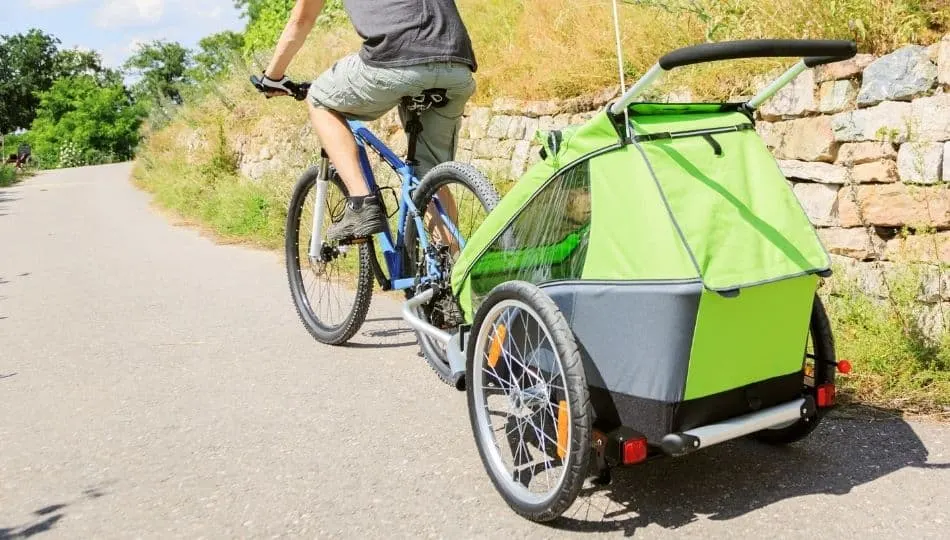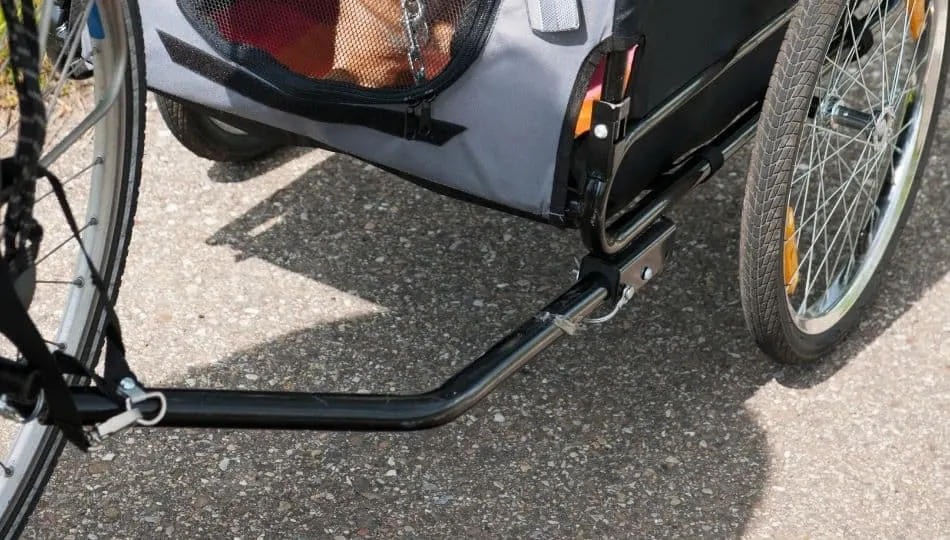
To any road-cycling enthusiast, a road bike is a forever companion on any journey, especially on leisure trips and long-distance rides. In most cases, road bicycles can even be an excellent choice for transporting goods and bicycle gear. Likewise, I recently considered using a bicycle trailer in order to transport larger quantities of goods with my road bike. I did some research to figure out whether this would be possible.
So, is it possible to pull a bicycle trailer using a road bike?
In most cases, it is possible to pull a trailer using a road bike. However, it will depend on the type of road bike you ride, the route you plan to ride, & the compatibility of the bike trailer. There are special trailers designed to attach to road bikes that create an easier experience for the rider.
However, attaching a bicycle trailer to your road bicycle and selecting the right gear and trailer for the job is not as simple as you might think. Before making use of a bicycle trailer with your road bicycle, it is essential to achieve a thorough understanding of the capabilities of both your road bike and your trailer. Keep reading to find out how you can efficiently make use of a bicycle trailer for your road bike…
What Type of Bicycle Trailers are Available for my Road Bike?
When considering using a trailer alongside your road bike, it is crucial that you are using a bicycle trailer. While there are alternate trailers for other vehicles that could theoretically attach to your road bike, different issues can arise… your bicycle or trailer’s components can be damaged or you may overexert yourself to name a few. Ensure that you are using a trailer that is designed specifically for road bikes.
There are actually a few different types of bicycle trailers you can attach to your road bikes that are designed for various objectives in mind. Note that some models may not be compatible with your specific road bike; however, many brands offer alternate variants that are suitable. Before picking a suitable bicycle trailer for your road bike, ensure that you understand each trailer’s specific functionality.
Here are some options…
- Trailers for toddlers and small children
These trailers are designed to give infants and small children a comfortable riding space. Likewise, these bicycle trailers are usually smaller in size and do not have sufficient spacing and compartments to carry a large amount of extra belongings or equipment.
- Trailers for up to two children
These trailers are significantly larger than the option stated above. While they are designed for children, their larger size allows you to carry extra belongings or equipment. Some trailers are even designed to allow two children to ride in the space simultaneously.
- Trailers for cargo
These trailers are designed to carry large amounts of equipment, gear and luggage — like groceries. For those that hope to purchase a trailer for the purposes of work or errand-related endeavours, this trailer is the best option. These trailers come in various sizes; pick one that suits your luggage-holding needs.
Note that these trailers are not designed for carrying children or other people. It can be uncomfortable, or even dangerous, to use this type of bicycle trailer to carry children in conjunction with its regular purpose.
Will my Road Bike Hold a Heavy Load?
There will be some road bikes that won’t be a good fit to use with trailers. Make sure your road bike has the following:
- Solid, durable frame
- Gears, especially lower gears
- Wheels that are at least 32 spoke
Any road bike that is extremely lightweight and doesn’t have gears won’t really work for a pulling a bike trailer, because they are designed to be fast, efficient and lightweight. And to pull a trailer, you’ll need some durability, solidness and strength (that’s where the low gears will come in handy) to pull the trailer.
How Much Do Bicycle Trailers Cost?
Obviously, this can vary based on the type of bicycle trailer you choose to buy, the size of the bicycle trailer, where you purchase from, as well as the brand. However, the average price for a decent-sized bicycle trailer ranges from approximately seventy dollars to four-hundred dollars.
For higher-quality trailers, this range can extend into one-thousand dollars. Usually, these trailers guarantee additional compartments and storage space (which means a larger carrying capacity) or a more comfortable space for your child or children. That is, the inclusion of padded seating or a drink-holder, for example.
How Do I Hook my Bicycle Trailer to my Road Bike?

For a bicycle newbie, attaching a bicycle trailer to your road bike is no easy feat. There are quite a few details that you must pay close attention to in order to ensure that your bicycle trailer is secured and that your belongings and passengers are safely carried or stowed away. Here’s a more detailed guide on how to properly attach your bicycle trailer:
- Identify and locate your bicycle trailer’s hitch. Your bicycle trailer’s hitch is the point where you will attach your road bike. Most commonly, you can attach your bicycle trailer’s hitch in three places: beside your vehicle’s rear fork, below the vehicle’s seat, or somewhere along your vehicle’s frame. If all the spots are available on your road bike, test which location will be most convenient and efficient for you and your bicycle trailer.
- Unlatch your bicycle trailer’s hitch and attach it to the preferred location on your road bike. While your bicycle trailer’s hitch will, more or less, act in a similar manner and do the same job, its locking mechanic can vary from trailer to trailer.
Some bicycle trailers require the use of screws, while others are able to lock itself using locks and such. This is an important feature to consider before settling on a bicycle trailer for purchase. However, do not worry! There should be instructions that come along with your bicycle trailer that will give you further detail regarding this mechanic.
- Attach the bicycle trailer onto your road bike. Using the various locking mechanics stated above, along with the bicycle trailer’s instructions, securely fasten and lock your bicycle trailer to your road bike. Ensure that there are seldom any loose screws or broken parts.
- Test your bicycle trailer. After securely attaching your bicycle trailer to your road bike, test it to ensure that it is functioning correctly and properly. It is recommended that you either do this by walking or slowly riding your bicycle around a vacant space, such as an empty parking lot. You can also test your bicycle trailer by strongly tugging on the locking mechanic to ensure that it stays in place.
- Load your luggage onto your bicycle trailer. Try out your trailer by loading your trailer with some sample items or children that you may want to carry. Take the trailer out for a test run around the neighbourhood. If you are carrying a young child, ensure that they are well-protected from debris and that they cannot accidentally unlatch or open the trailer.
Some Tips for Using your Bicycle Trailer Effectively
Cycling with a trailer is a significantly different experience than just riding a bicycle alone. Below are some tips to those that plan to use a bicycle trailer regularly.
- Always use lower gears when possible. Using lower gears will allow you to get the most out of your energy; it will give you the largest possible distance when pedalling, making your biking experience less tiring.
- Travel on routes that have smooth terrain. Although your trailer may not necessarily be damaged by these bumps, it may not exactly be good for the items or passengers you are bringing along.
- Make wider turns. Because your bicycle is now “wider” and “larger”, you cannot make quick and sharp turns any longer. Give your whole vehicle enough space to turn, especially on narrow roads.
- Plan your route wisely. Bear in mind that your trailer is wider than your bike in many cases, so your route must also allow for this extra space (including make wider turns as mentioned before).
- Practice with your empty trailer. Riding with your trailer will take some getting used to, so it’s a good idea to get some practice in before you fill it with a heavy load so that you can start to get a feel for adjustments you’ll need to make in your riding technique.
Final Thoughts
With the ever-increasing size of the cycling community, there is also an ever-increasing amount of customization available for your bicycle, one being the bicycle trailer. Not only does it give you extra space to carry belongings that the usual bicycle lacks, it even gives you the option of bringing your child along! Just ensure you purchase a suitable model for your job, secure it carefully, and get to biking!
